Intoxication Defense and Criminal Liability
VerifiedAdded on 2020/06/05
|9
|1922
|50
AI Summary
This assignment delves into the legal concept of intoxication as a defense against criminal liability. It utilizes the hypothetical case of Peter, who punched a student after consuming two bottles of wine, to analyze the applicability of this defense. The assignment considers the relevant legal principles such as mens rea and actus reus, referencing the landmark case DPP v Majewski (1977). It ultimately concludes that Peter's actions likely constitute battery due to the lack of a successful intoxication defense in this scenario.
Contribute Materials
Your contribution can guide someone’s learning journey. Share your
documents today.
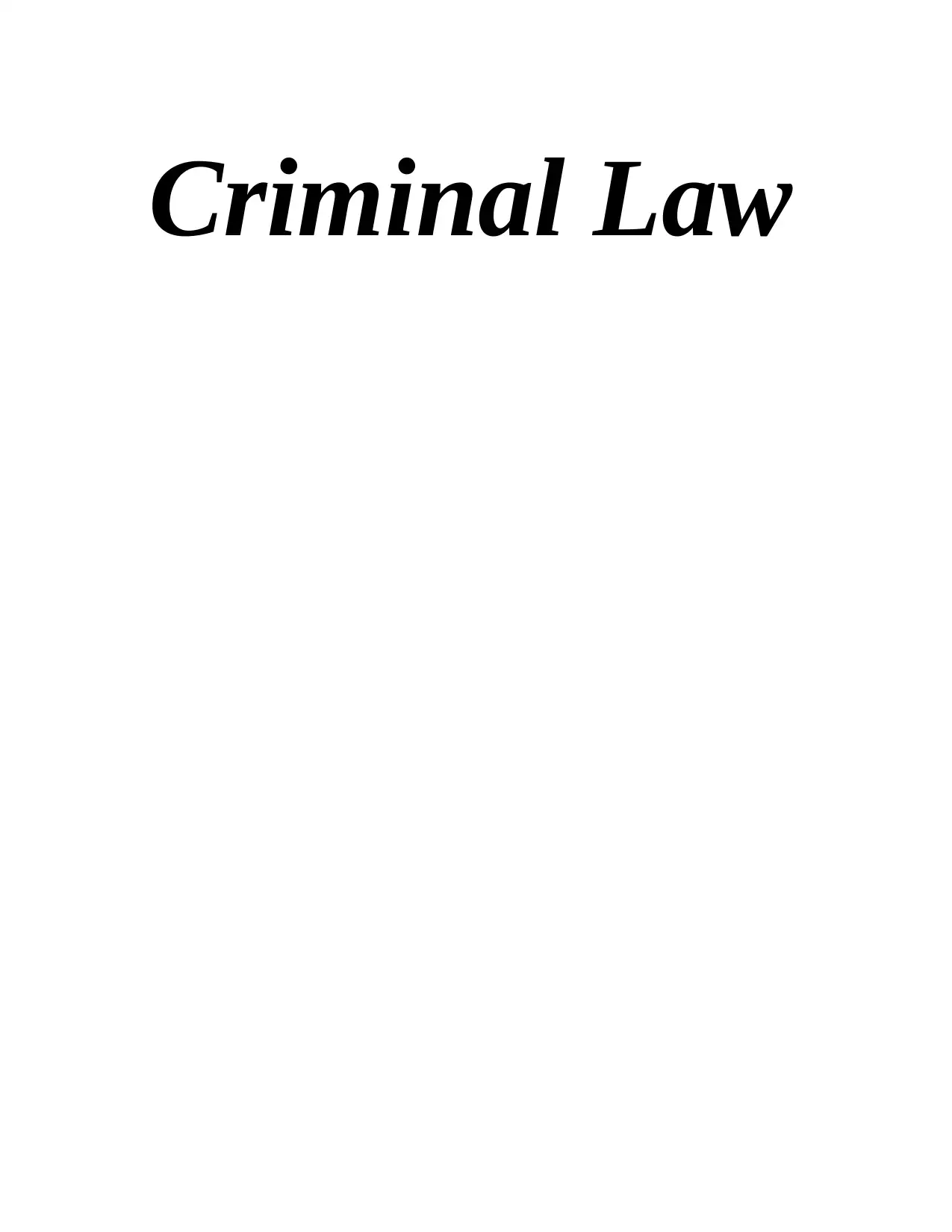
Criminal Law
Secure Best Marks with AI Grader
Need help grading? Try our AI Grader for instant feedback on your assignments.
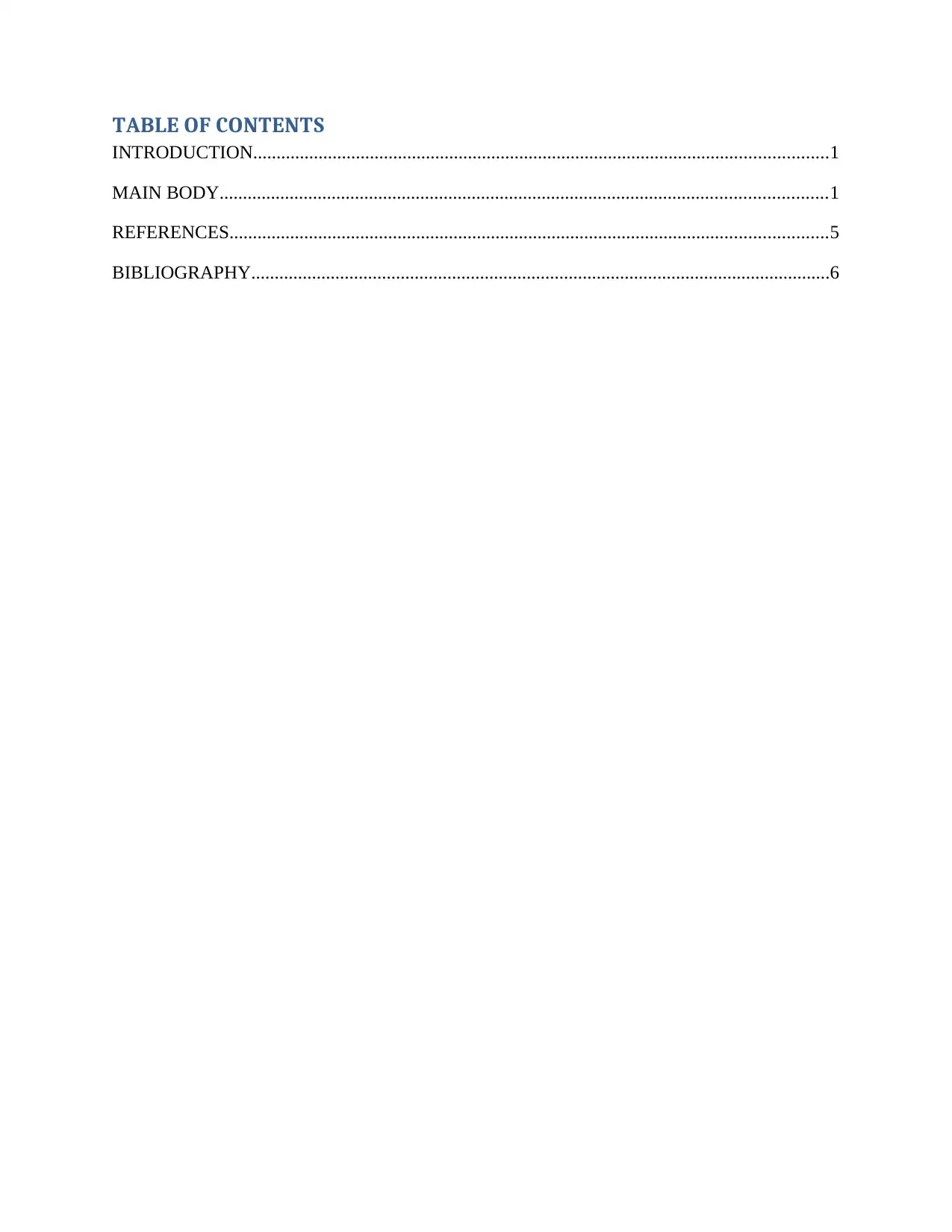
TABLE OF CONTENTS
INTRODUCTION...........................................................................................................................1
MAIN BODY..................................................................................................................................1
REFERENCES................................................................................................................................5
BIBLIOGRAPHY............................................................................................................................6
INTRODUCTION...........................................................................................................................1
MAIN BODY..................................................................................................................................1
REFERENCES................................................................................................................................5
BIBLIOGRAPHY............................................................................................................................6
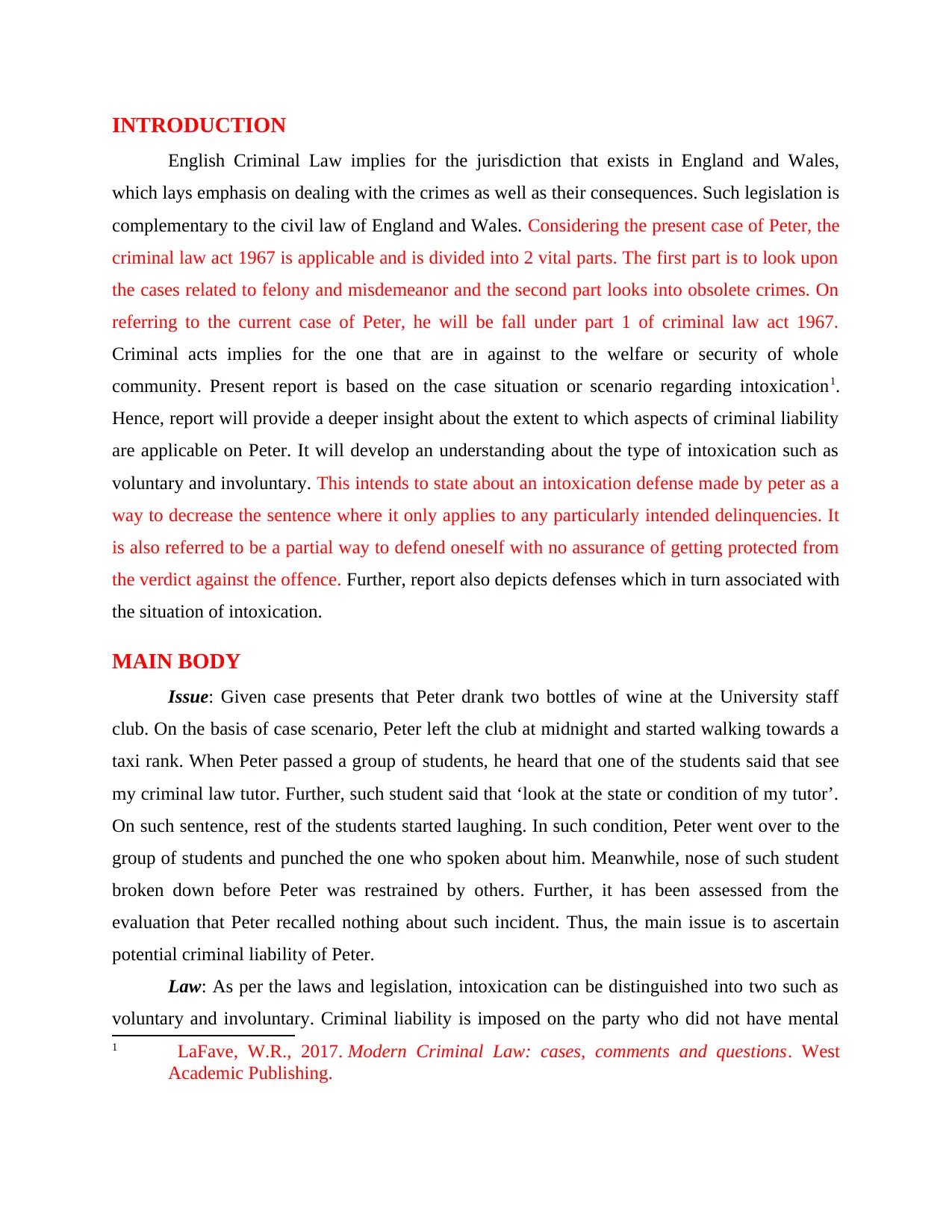
INTRODUCTION
English Criminal Law implies for the jurisdiction that exists in England and Wales,
which lays emphasis on dealing with the crimes as well as their consequences. Such legislation is
complementary to the civil law of England and Wales. Considering the present case of Peter, the
criminal law act 1967 is applicable and is divided into 2 vital parts. The first part is to look upon
the cases related to felony and misdemeanor and the second part looks into obsolete crimes. On
referring to the current case of Peter, he will be fall under part 1 of criminal law act 1967.
Criminal acts implies for the one that are in against to the welfare or security of whole
community. Present report is based on the case situation or scenario regarding intoxication1.
Hence, report will provide a deeper insight about the extent to which aspects of criminal liability
are applicable on Peter. It will develop an understanding about the type of intoxication such as
voluntary and involuntary. This intends to state about an intoxication defense made by peter as a
way to decrease the sentence where it only applies to any particularly intended delinquencies. It
is also referred to be a partial way to defend oneself with no assurance of getting protected from
the verdict against the offence. Further, report also depicts defenses which in turn associated with
the situation of intoxication.
MAIN BODY
Issue: Given case presents that Peter drank two bottles of wine at the University staff
club. On the basis of case scenario, Peter left the club at midnight and started walking towards a
taxi rank. When Peter passed a group of students, he heard that one of the students said that see
my criminal law tutor. Further, such student said that ‘look at the state or condition of my tutor’.
On such sentence, rest of the students started laughing. In such condition, Peter went over to the
group of students and punched the one who spoken about him. Meanwhile, nose of such student
broken down before Peter was restrained by others. Further, it has been assessed from the
evaluation that Peter recalled nothing about such incident. Thus, the main issue is to ascertain
potential criminal liability of Peter.
Law: As per the laws and legislation, intoxication can be distinguished into two such as
voluntary and involuntary. Criminal liability is imposed on the party who did not have mental
1 LaFave, W.R., 2017. Modern Criminal Law: cases, comments and questions. West
Academic Publishing.
English Criminal Law implies for the jurisdiction that exists in England and Wales,
which lays emphasis on dealing with the crimes as well as their consequences. Such legislation is
complementary to the civil law of England and Wales. Considering the present case of Peter, the
criminal law act 1967 is applicable and is divided into 2 vital parts. The first part is to look upon
the cases related to felony and misdemeanor and the second part looks into obsolete crimes. On
referring to the current case of Peter, he will be fall under part 1 of criminal law act 1967.
Criminal acts implies for the one that are in against to the welfare or security of whole
community. Present report is based on the case situation or scenario regarding intoxication1.
Hence, report will provide a deeper insight about the extent to which aspects of criminal liability
are applicable on Peter. It will develop an understanding about the type of intoxication such as
voluntary and involuntary. This intends to state about an intoxication defense made by peter as a
way to decrease the sentence where it only applies to any particularly intended delinquencies. It
is also referred to be a partial way to defend oneself with no assurance of getting protected from
the verdict against the offence. Further, report also depicts defenses which in turn associated with
the situation of intoxication.
MAIN BODY
Issue: Given case presents that Peter drank two bottles of wine at the University staff
club. On the basis of case scenario, Peter left the club at midnight and started walking towards a
taxi rank. When Peter passed a group of students, he heard that one of the students said that see
my criminal law tutor. Further, such student said that ‘look at the state or condition of my tutor’.
On such sentence, rest of the students started laughing. In such condition, Peter went over to the
group of students and punched the one who spoken about him. Meanwhile, nose of such student
broken down before Peter was restrained by others. Further, it has been assessed from the
evaluation that Peter recalled nothing about such incident. Thus, the main issue is to ascertain
potential criminal liability of Peter.
Law: As per the laws and legislation, intoxication can be distinguished into two such as
voluntary and involuntary. Criminal liability is imposed on the party who did not have mental
1 LaFave, W.R., 2017. Modern Criminal Law: cases, comments and questions. West
Academic Publishing.
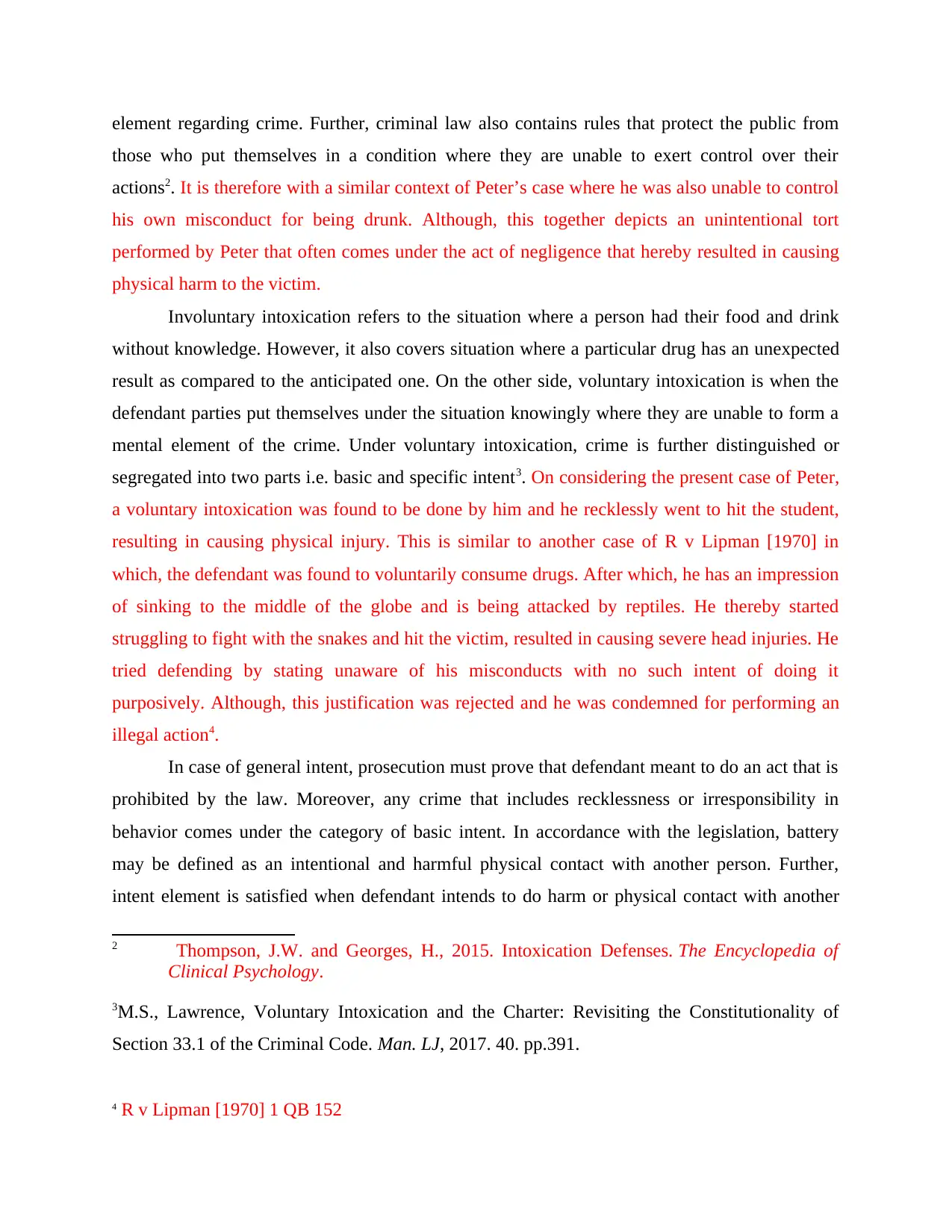
element regarding crime. Further, criminal law also contains rules that protect the public from
those who put themselves in a condition where they are unable to exert control over their
actions2. It is therefore with a similar context of Peter’s case where he was also unable to control
his own misconduct for being drunk. Although, this together depicts an unintentional tort
performed by Peter that often comes under the act of negligence that hereby resulted in causing
physical harm to the victim.
Involuntary intoxication refers to the situation where a person had their food and drink
without knowledge. However, it also covers situation where a particular drug has an unexpected
result as compared to the anticipated one. On the other side, voluntary intoxication is when the
defendant parties put themselves under the situation knowingly where they are unable to form a
mental element of the crime. Under voluntary intoxication, crime is further distinguished or
segregated into two parts i.e. basic and specific intent3. On considering the present case of Peter,
a voluntary intoxication was found to be done by him and he recklessly went to hit the student,
resulting in causing physical injury. This is similar to another case of R v Lipman [1970] in
which, the defendant was found to voluntarily consume drugs. After which, he has an impression
of sinking to the middle of the globe and is being attacked by reptiles. He thereby started
struggling to fight with the snakes and hit the victim, resulted in causing severe head injuries. He
tried defending by stating unaware of his misconducts with no such intent of doing it
purposively. Although, this justification was rejected and he was condemned for performing an
illegal action4.
In case of general intent, prosecution must prove that defendant meant to do an act that is
prohibited by the law. Moreover, any crime that includes recklessness or irresponsibility in
behavior comes under the category of basic intent. In accordance with the legislation, battery
may be defined as an intentional and harmful physical contact with another person. Further,
intent element is satisfied when defendant intends to do harm or physical contact with another
2 Thompson, J.W. and Georges, H., 2015. Intoxication Defenses. The Encyclopedia of
Clinical Psychology.
3M.S., Lawrence, Voluntary Intoxication and the Charter: Revisiting the Constitutionality of
Section 33.1 of the Criminal Code. Man. LJ, 2017. 40. pp.391.
4 R v Lipman [1970] 1 QB 152
those who put themselves in a condition where they are unable to exert control over their
actions2. It is therefore with a similar context of Peter’s case where he was also unable to control
his own misconduct for being drunk. Although, this together depicts an unintentional tort
performed by Peter that often comes under the act of negligence that hereby resulted in causing
physical harm to the victim.
Involuntary intoxication refers to the situation where a person had their food and drink
without knowledge. However, it also covers situation where a particular drug has an unexpected
result as compared to the anticipated one. On the other side, voluntary intoxication is when the
defendant parties put themselves under the situation knowingly where they are unable to form a
mental element of the crime. Under voluntary intoxication, crime is further distinguished or
segregated into two parts i.e. basic and specific intent3. On considering the present case of Peter,
a voluntary intoxication was found to be done by him and he recklessly went to hit the student,
resulting in causing physical injury. This is similar to another case of R v Lipman [1970] in
which, the defendant was found to voluntarily consume drugs. After which, he has an impression
of sinking to the middle of the globe and is being attacked by reptiles. He thereby started
struggling to fight with the snakes and hit the victim, resulted in causing severe head injuries. He
tried defending by stating unaware of his misconducts with no such intent of doing it
purposively. Although, this justification was rejected and he was condemned for performing an
illegal action4.
In case of general intent, prosecution must prove that defendant meant to do an act that is
prohibited by the law. Moreover, any crime that includes recklessness or irresponsibility in
behavior comes under the category of basic intent. In accordance with the legislation, battery
may be defined as an intentional and harmful physical contact with another person. Further,
intent element is satisfied when defendant intends to do harm or physical contact with another
2 Thompson, J.W. and Georges, H., 2015. Intoxication Defenses. The Encyclopedia of
Clinical Psychology.
3M.S., Lawrence, Voluntary Intoxication and the Charter: Revisiting the Constitutionality of
Section 33.1 of the Criminal Code. Man. LJ, 2017. 40. pp.391.
4 R v Lipman [1970] 1 QB 152
Secure Best Marks with AI Grader
Need help grading? Try our AI Grader for instant feedback on your assignments.
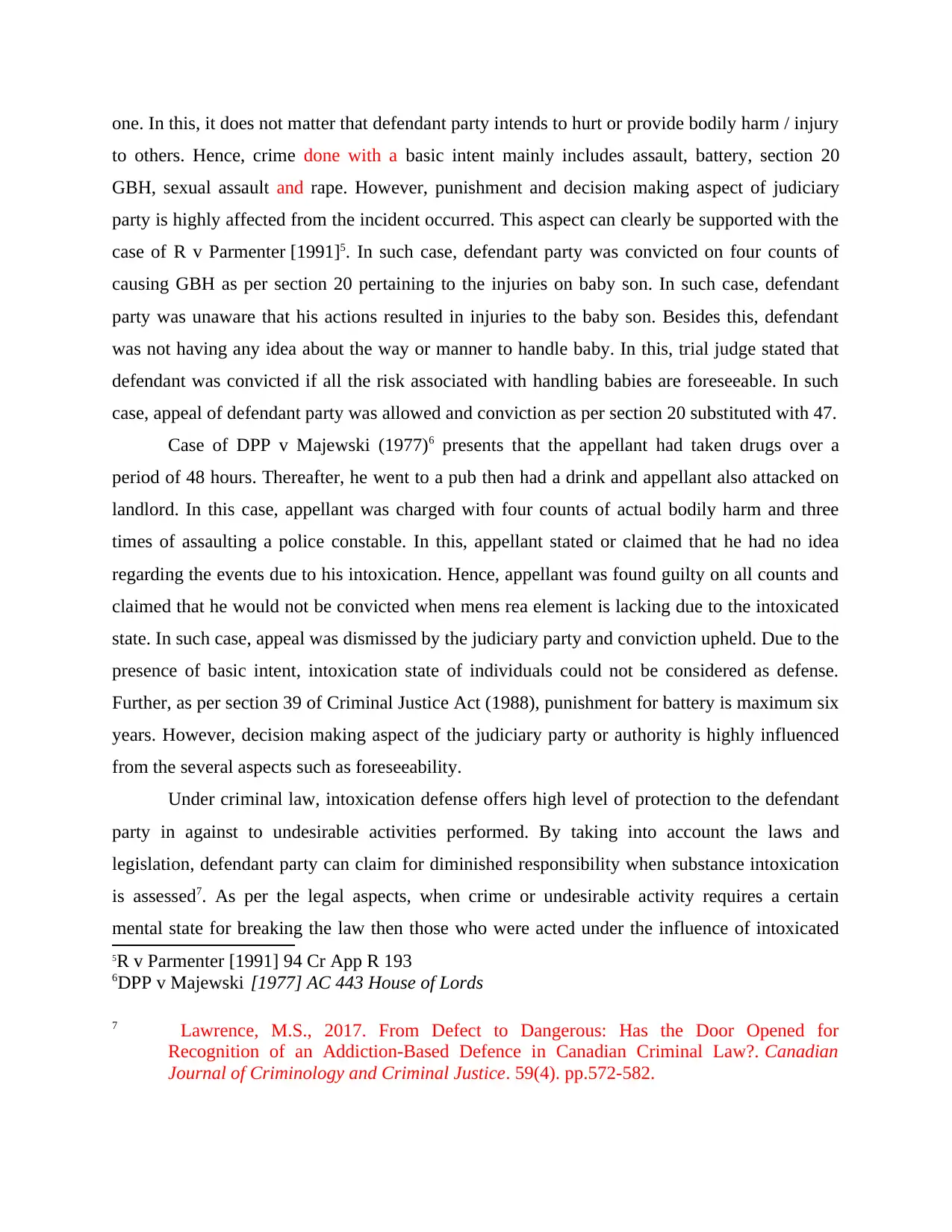
one. In this, it does not matter that defendant party intends to hurt or provide bodily harm / injury
to others. Hence, crime done with a basic intent mainly includes assault, battery, section 20
GBH, sexual assault and rape. However, punishment and decision making aspect of judiciary
party is highly affected from the incident occurred. This aspect can clearly be supported with the
case of R v Parmenter [1991]5. In such case, defendant party was convicted on four counts of
causing GBH as per section 20 pertaining to the injuries on baby son. In such case, defendant
party was unaware that his actions resulted in injuries to the baby son. Besides this, defendant
was not having any idea about the way or manner to handle baby. In this, trial judge stated that
defendant was convicted if all the risk associated with handling babies are foreseeable. In such
case, appeal of defendant party was allowed and conviction as per section 20 substituted with 47.
Case of DPP v Majewski (1977)6 presents that the appellant had taken drugs over a
period of 48 hours. Thereafter, he went to a pub then had a drink and appellant also attacked on
landlord. In this case, appellant was charged with four counts of actual bodily harm and three
times of assaulting a police constable. In this, appellant stated or claimed that he had no idea
regarding the events due to his intoxication. Hence, appellant was found guilty on all counts and
claimed that he would not be convicted when mens rea element is lacking due to the intoxicated
state. In such case, appeal was dismissed by the judiciary party and conviction upheld. Due to the
presence of basic intent, intoxication state of individuals could not be considered as defense.
Further, as per section 39 of Criminal Justice Act (1988), punishment for battery is maximum six
years. However, decision making aspect of the judiciary party or authority is highly influenced
from the several aspects such as foreseeability.
Under criminal law, intoxication defense offers high level of protection to the defendant
party in against to undesirable activities performed. By taking into account the laws and
legislation, defendant party can claim for diminished responsibility when substance intoxication
is assessed7. As per the legal aspects, when crime or undesirable activity requires a certain
mental state for breaking the law then those who were acted under the influence of intoxicated
5R v Parmenter [1991] 94 Cr App R 193
6DPP v Majewski [1977] AC 443 House of Lords
7 Lawrence, M.S., 2017. From Defect to Dangerous: Has the Door Opened for
Recognition of an Addiction-Based Defence in Canadian Criminal Law?. Canadian
Journal of Criminology and Criminal Justice. 59(4). pp.572-582.
to others. Hence, crime done with a basic intent mainly includes assault, battery, section 20
GBH, sexual assault and rape. However, punishment and decision making aspect of judiciary
party is highly affected from the incident occurred. This aspect can clearly be supported with the
case of R v Parmenter [1991]5. In such case, defendant party was convicted on four counts of
causing GBH as per section 20 pertaining to the injuries on baby son. In such case, defendant
party was unaware that his actions resulted in injuries to the baby son. Besides this, defendant
was not having any idea about the way or manner to handle baby. In this, trial judge stated that
defendant was convicted if all the risk associated with handling babies are foreseeable. In such
case, appeal of defendant party was allowed and conviction as per section 20 substituted with 47.
Case of DPP v Majewski (1977)6 presents that the appellant had taken drugs over a
period of 48 hours. Thereafter, he went to a pub then had a drink and appellant also attacked on
landlord. In this case, appellant was charged with four counts of actual bodily harm and three
times of assaulting a police constable. In this, appellant stated or claimed that he had no idea
regarding the events due to his intoxication. Hence, appellant was found guilty on all counts and
claimed that he would not be convicted when mens rea element is lacking due to the intoxicated
state. In such case, appeal was dismissed by the judiciary party and conviction upheld. Due to the
presence of basic intent, intoxication state of individuals could not be considered as defense.
Further, as per section 39 of Criminal Justice Act (1988), punishment for battery is maximum six
years. However, decision making aspect of the judiciary party or authority is highly influenced
from the several aspects such as foreseeability.
Under criminal law, intoxication defense offers high level of protection to the defendant
party in against to undesirable activities performed. By taking into account the laws and
legislation, defendant party can claim for diminished responsibility when substance intoxication
is assessed7. As per the legal aspects, when crime or undesirable activity requires a certain
mental state for breaking the law then those who were acted under the influence of intoxicated
5R v Parmenter [1991] 94 Cr App R 193
6DPP v Majewski [1977] AC 443 House of Lords
7 Lawrence, M.S., 2017. From Defect to Dangerous: Has the Door Opened for
Recognition of an Addiction-Based Defence in Canadian Criminal Law?. Canadian
Journal of Criminology and Criminal Justice. 59(4). pp.572-582.
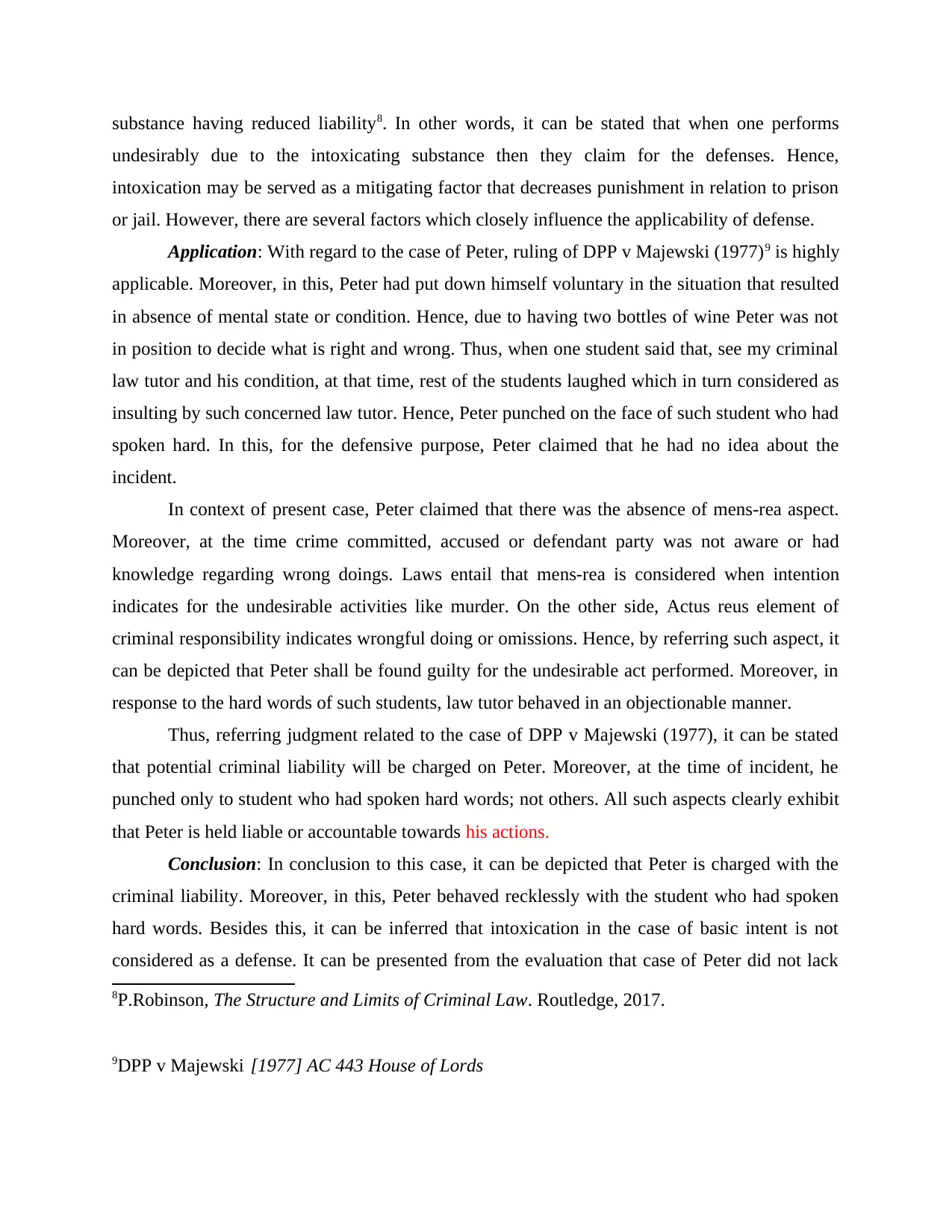
substance having reduced liability8. In other words, it can be stated that when one performs
undesirably due to the intoxicating substance then they claim for the defenses. Hence,
intoxication may be served as a mitigating factor that decreases punishment in relation to prison
or jail. However, there are several factors which closely influence the applicability of defense.
Application: With regard to the case of Peter, ruling of DPP v Majewski (1977)9 is highly
applicable. Moreover, in this, Peter had put down himself voluntary in the situation that resulted
in absence of mental state or condition. Hence, due to having two bottles of wine Peter was not
in position to decide what is right and wrong. Thus, when one student said that, see my criminal
law tutor and his condition, at that time, rest of the students laughed which in turn considered as
insulting by such concerned law tutor. Hence, Peter punched on the face of such student who had
spoken hard. In this, for the defensive purpose, Peter claimed that he had no idea about the
incident.
In context of present case, Peter claimed that there was the absence of mens-rea aspect.
Moreover, at the time crime committed, accused or defendant party was not aware or had
knowledge regarding wrong doings. Laws entail that mens-rea is considered when intention
indicates for the undesirable activities like murder. On the other side, Actus reus element of
criminal responsibility indicates wrongful doing or omissions. Hence, by referring such aspect, it
can be depicted that Peter shall be found guilty for the undesirable act performed. Moreover, in
response to the hard words of such students, law tutor behaved in an objectionable manner.
Thus, referring judgment related to the case of DPP v Majewski (1977), it can be stated
that potential criminal liability will be charged on Peter. Moreover, at the time of incident, he
punched only to student who had spoken hard words; not others. All such aspects clearly exhibit
that Peter is held liable or accountable towards his actions.
Conclusion: In conclusion to this case, it can be depicted that Peter is charged with the
criminal liability. Moreover, in this, Peter behaved recklessly with the student who had spoken
hard words. Besides this, it can be inferred that intoxication in the case of basic intent is not
considered as a defense. It can be presented from the evaluation that case of Peter did not lack
8P.Robinson, The Structure and Limits of Criminal Law. Routledge, 2017.
9DPP v Majewski [1977] AC 443 House of Lords
undesirably due to the intoxicating substance then they claim for the defenses. Hence,
intoxication may be served as a mitigating factor that decreases punishment in relation to prison
or jail. However, there are several factors which closely influence the applicability of defense.
Application: With regard to the case of Peter, ruling of DPP v Majewski (1977)9 is highly
applicable. Moreover, in this, Peter had put down himself voluntary in the situation that resulted
in absence of mental state or condition. Hence, due to having two bottles of wine Peter was not
in position to decide what is right and wrong. Thus, when one student said that, see my criminal
law tutor and his condition, at that time, rest of the students laughed which in turn considered as
insulting by such concerned law tutor. Hence, Peter punched on the face of such student who had
spoken hard. In this, for the defensive purpose, Peter claimed that he had no idea about the
incident.
In context of present case, Peter claimed that there was the absence of mens-rea aspect.
Moreover, at the time crime committed, accused or defendant party was not aware or had
knowledge regarding wrong doings. Laws entail that mens-rea is considered when intention
indicates for the undesirable activities like murder. On the other side, Actus reus element of
criminal responsibility indicates wrongful doing or omissions. Hence, by referring such aspect, it
can be depicted that Peter shall be found guilty for the undesirable act performed. Moreover, in
response to the hard words of such students, law tutor behaved in an objectionable manner.
Thus, referring judgment related to the case of DPP v Majewski (1977), it can be stated
that potential criminal liability will be charged on Peter. Moreover, at the time of incident, he
punched only to student who had spoken hard words; not others. All such aspects clearly exhibit
that Peter is held liable or accountable towards his actions.
Conclusion: In conclusion to this case, it can be depicted that Peter is charged with the
criminal liability. Moreover, in this, Peter behaved recklessly with the student who had spoken
hard words. Besides this, it can be inferred that intoxication in the case of basic intent is not
considered as a defense. It can be presented from the evaluation that case of Peter did not lack
8P.Robinson, The Structure and Limits of Criminal Law. Routledge, 2017.
9DPP v Majewski [1977] AC 443 House of Lords
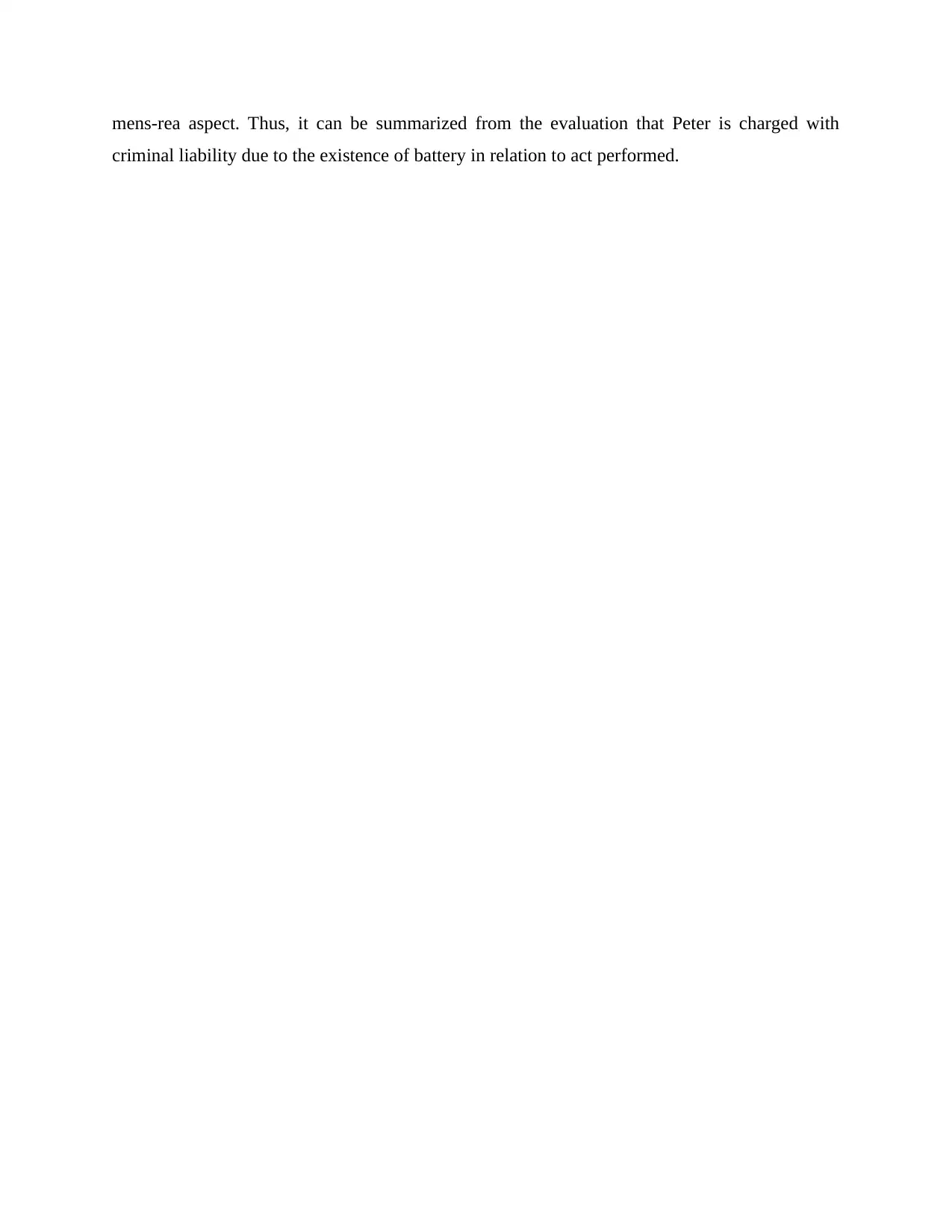
mens-rea aspect. Thus, it can be summarized from the evaluation that Peter is charged with
criminal liability due to the existence of battery in relation to act performed.
criminal liability due to the existence of battery in relation to act performed.
Paraphrase This Document
Need a fresh take? Get an instant paraphrase of this document with our AI Paraphraser
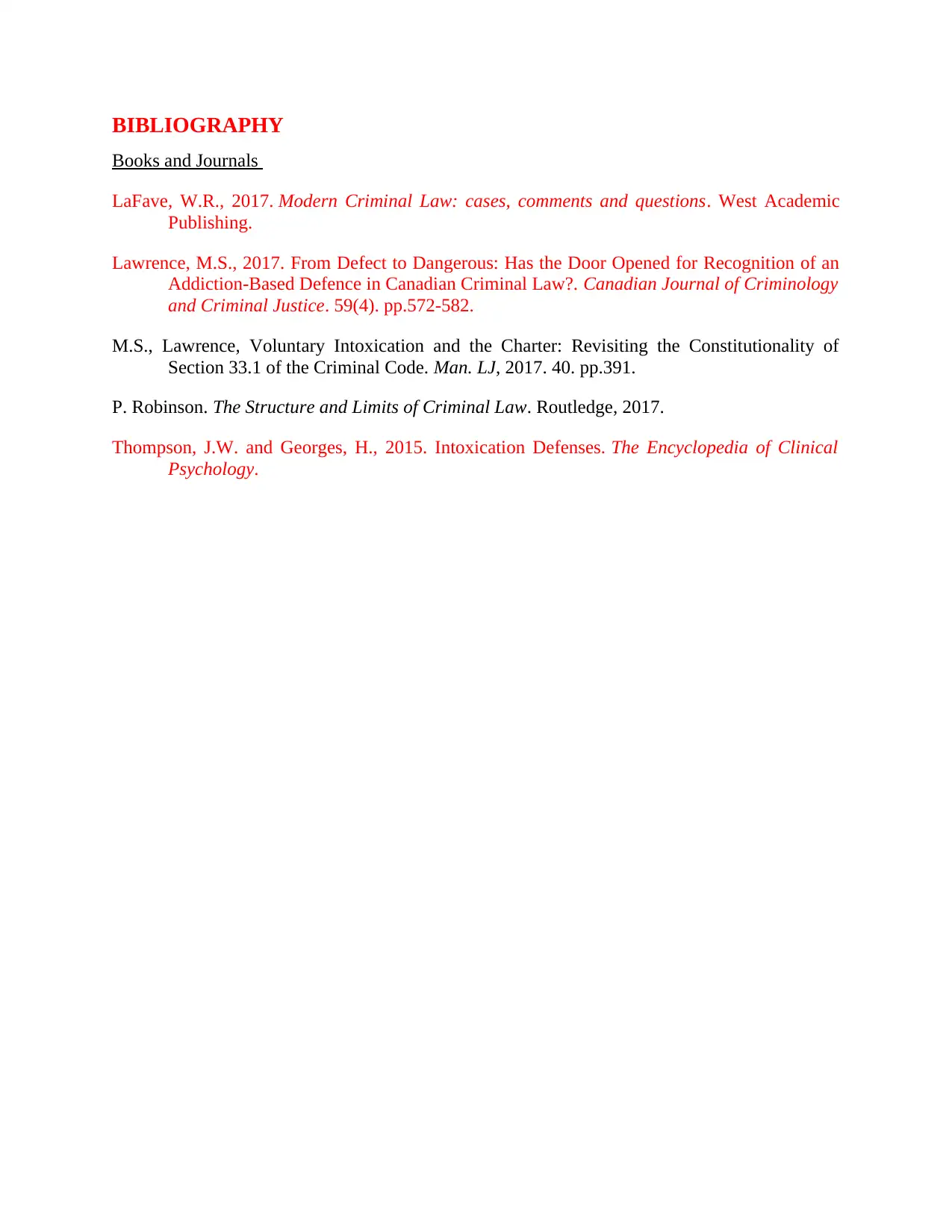
BIBLIOGRAPHY
Books and Journals
LaFave, W.R., 2017. Modern Criminal Law: cases, comments and questions. West Academic
Publishing.
Lawrence, M.S., 2017. From Defect to Dangerous: Has the Door Opened for Recognition of an
Addiction-Based Defence in Canadian Criminal Law?. Canadian Journal of Criminology
and Criminal Justice. 59(4). pp.572-582.
M.S., Lawrence, Voluntary Intoxication and the Charter: Revisiting the Constitutionality of
Section 33.1 of the Criminal Code. Man. LJ, 2017. 40. pp.391.
P. Robinson. The Structure and Limits of Criminal Law. Routledge, 2017.
Thompson, J.W. and Georges, H., 2015. Intoxication Defenses. The Encyclopedia of Clinical
Psychology.
Books and Journals
LaFave, W.R., 2017. Modern Criminal Law: cases, comments and questions. West Academic
Publishing.
Lawrence, M.S., 2017. From Defect to Dangerous: Has the Door Opened for Recognition of an
Addiction-Based Defence in Canadian Criminal Law?. Canadian Journal of Criminology
and Criminal Justice. 59(4). pp.572-582.
M.S., Lawrence, Voluntary Intoxication and the Charter: Revisiting the Constitutionality of
Section 33.1 of the Criminal Code. Man. LJ, 2017. 40. pp.391.
P. Robinson. The Structure and Limits of Criminal Law. Routledge, 2017.
Thompson, J.W. and Georges, H., 2015. Intoxication Defenses. The Encyclopedia of Clinical
Psychology.

1 out of 9
Related Documents
Your All-in-One AI-Powered Toolkit for Academic Success.
+13062052269
info@desklib.com
Available 24*7 on WhatsApp / Email
![[object Object]](/_next/static/media/star-bottom.7253800d.svg)
Unlock your academic potential
© 2024 | Zucol Services PVT LTD | All rights reserved.





